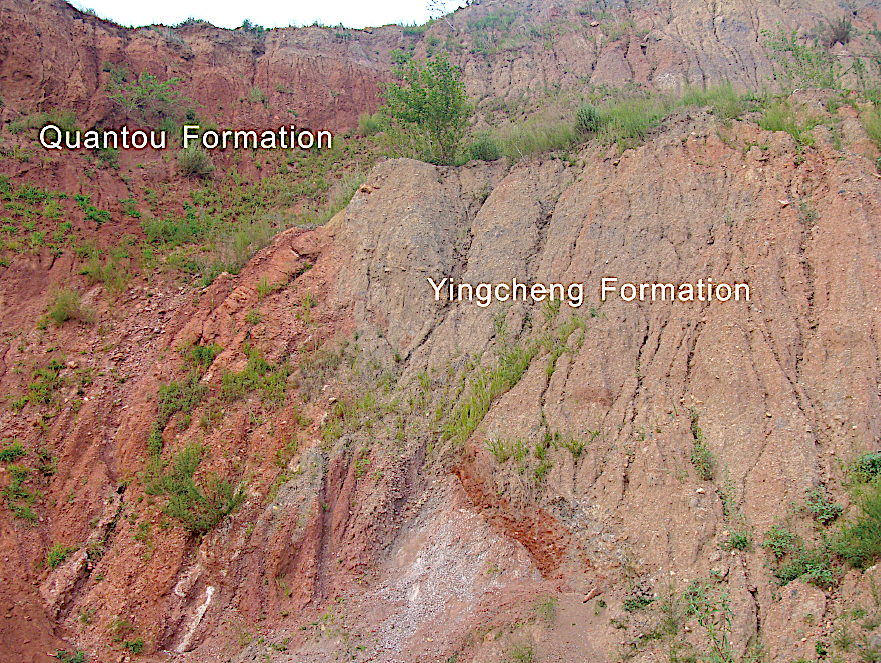Yingcheng Fm
Type Locality and Naming
Songliao Basin. G. Morita erected the Yingchengzi volcanic group in 1941. The type locality for the designation is in Yingcheng of the Jiutai City of Jilin. The reference section is down the boreholes No.341 and 343 of the Yingcheng Coalfield of the Jiutai City of Jilin.
Lithology and Thickness
The Yingcheng Formation is represented by a set of intermediate and acid coal-bearing volcanic rocks, which is divided into three parts. Lower part is represented by gray purple and gray green andesitic tuff and andesite; Middle part is dominated by tuffaceous conglomerate and sandstone with andesite; Upper part is rhyolitic tuff and rhyolite with tuffaceous sandstone, conglomerate and coal beds. The Yingcheng Formation is 860.5 m thick.
Relationships and Distribution
Lower contact
The base of the formation marked by andesite basalt lies disconformably on the underlying Shahezi Fm.
Upper contact
The top marked by gray green rhyolite lies unconformably under the red conglomerate o the overlying Quantou Fm.
[Figure: Contact between gray rhyolitic tuff of Yingcheng Formation and red conglomerate of Quantou Fm in Jijialing of Changtu County, Liaoning Province]
Regional extent
The present formation is mainly distributed in the Yingcheng coalfield, Shibeiling and Liujiayoufang areas. It varies considerably both in lithology and thickness. In the Huihuiying-Guanmashan area, basic volcanic rocks of the lower part of the formation is absent; in the Maanshan-Yujiadian area there occur compositionally compound conglomerate bed at the base of the formation, with a thickness of 1175 m; in the Jingyue-Dadingzishan area of Changchun, the formation is built up by gray white and gray purple rhyolite with a small amount of gravel-bearing sandstone with coal streaks at the base, 165 m thick, unconformably lying on granite; in the Yangcaogou area of the Jiutai City, the lower part of the formation is dominated by pyroxene andesite, the middle part rhyolite and the upper part normal clastic sedimentary rocks with coal beds, about 600 m thick. The present formation richly yields perlite, bentonite zeolite, etc.
GeoJSON
Fossils
The formation yields plant fossils, spores and pollen, conchostracans, ostracods and the brackish-water Vesperopsis - Balmula dinocyst assemblage including Balmula granorugosa, Balmula sp. and Pseudoceratium sp. It yields floras Coniopteris onychioides, Cladophlebis sp.; in the Yingcheng Town of Jiutai, bivalves Ferganoconcha cf. daqingshanensis, F. laioxiensis, Sibireconcha golouae; insects Archaeogomphus sp., Clypostemma xyphilia; and floras Coniopteris cf. burejensis; and in the Yingcheng coalfield, ostracods Cypridea sp., Lycopterocypris torsuosus.
Age
Depositional setting
It mainly belongs to volcanic eruptive facies, normal clastic deposition, locally swamp facies.
Additional Information
Enhanced with Igor N. Kosenko, Jingeng Sha and Boris N. Shurygin (2021). Upper Mesozoic stratigraphy of Sikhote-Alin (Russian Far East) and northeastern China: Non-marine and marine correlations. Part 1: Upper Jurassic-Hauterivian AND 2. Barremian-Aptian. Cretaceous Research, 124: articles 104811 (https://doi.org/10.1016/j.cretres.2021.104811) AND 104812 (https://doi.org/10.1016/j.cretres.2021.104812)
